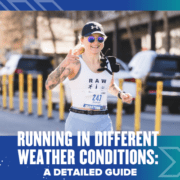Running in Different Weather Conditions: A Detailed Guide
With the Austin Marathon, Half Marathon & 5K just around the corner in February, it’s time to fine-tune your training—no matter the weather! Running outdoors offers a refreshing experience, but varying conditions in winter and early spring require specific preparations to keep you safe, comfortable, and performing your best. Whether you’re logging miles in cooler temps, navigating rainy days, or squeezing in runs before sunrise, having the right gear and strategies is key to crossing that finish line feeling strong.
Here’s a comprehensive breakdown to help you adjust your running attire and approach based on temperature, rain, and darkness, so you’re ready for anything come race day.
Temperature-Based Running Gear Recommendations
Understanding how to dress appropriately for different temperatures is crucial for maintaining comfort and performance during your runs. Below is a guide to help you choose the right attire based on the temperature:
|
Temperature Range (°F)
|
Clothing Recommendations
|
|
75°F and Above
|
Top: Lightweight, moisture-wicking tank or T-shirt.
Bottom: Breathable shorts.
Accessories: Cap or visor for sun protection; sunglasses; sunscreen.
Footwear: Well-ventilated running shoes; lightweight socks.
|
|
65–74°F
|
Top: Moisture-wicking short-sleeve shirt.
Bottom: Shorts.
Accessories: Optional cap; sunglasses.
Footwear: Standard running shoes; moisture-wicking socks.
|
|
55–64°F
|
Top: Long-sleeve moisture-wicking shirt or a short-sleeve shirt with arm sleeves.
Bottom: Shorts or capris.
Accessories: Light gloves if hands get cold.
Footwear: Running shoes; moisture-wicking socks.
|
|
45–54°F
|
Top: Long-sleeve shirt; lightweight jacket or vest.
Bottom: Capris or full-length tights.
Accessories: Gloves; headband or beanie.
Footwear: Running shoes; thicker socks.
|
|
35–44°F
|
Top: Thermal long-sleeve base layer; wind-resistant jacket.
Bottom: Full-length thermal tights.
Accessories: Insulated gloves; beanie; neck gaiter.
Footwear: Running shoes; thermal socks.
|
|
Below 35°F
|
Top: Thermal base layer; insulating mid-layer; windproof and waterproof outer layer.
Bottom: Thermal tights; consider layering with wind-resistant pants.
Accessories: Heavy-duty gloves; thermal hat; face mask or balaclava.
Footwear: Running shoes with good traction; thermal, moisture-wicking socks.
|
Note: These recommendations are general guidelines. Individual preferences and tolerance to cold or heat may vary. Always adjust based on personal comfort and specific weather conditions.
Running in the Rain
Running in the rain can be invigorating, but it requires additional precautions to ensure safety and comfort.
Clothing and Gear:
- Waterproof Jacket: Invest in a lightweight, breathable waterproof jacket to stay dry without overheating. Look for brans that offer reflective options that enhance visibility in low-light, rainy conditions.
- Footwear: Wear running shoes with good traction to prevent slipping. Consider shoes designed for wet conditions or use waterproof socks to keep feet dry.
- Hat with Brim: A cap can help keep rain out of your eyes, improving visibility.
Safety Tips:
- Visibility: Rain can reduce visibility for both runners and drivers. Wear bright, reflective clothing to ensure you’re seen. Reflective running jackets are particularly effective.
- Avoid Puddles: Running through puddles can lead to wet feet, increasing the risk of blisters. It can also conceal hazards like potholes.
- Post-Run Care: Change out of wet clothing immediately after your run to prevent chills and skin irritation.
Running in the Dark
Running during early mornings or late evenings requires heightened awareness and specific gear to ensure safety.
Clothing and Gear:
- Reflective Apparel: Wear clothing with reflective elements to increase visibility. Reflective vests, jackets, and armbands are effective choices.
- Headlamp or Handheld Light: Illuminating your path helps prevent trips and falls, and makes you visible to others.
- Avoid Headphones: Staying alert is crucial. If you must listen to music, keep the volume low or use bone-conduction headphones to remain aware of your surroundings.
Safety Tips:
- Run Against Traffic: When running on roads, face oncoming traffic to see and react to vehicles.
- Stay on Familiar Routes: Stick to well-lit, familiar paths to reduce the risk of accidents.
- Inform Someone: Let someone know your running route and expected return time.
Additional Tips for Adverse Conditions
- Layering: In cold or variable conditions, layering allows you to adjust clothing as needed. Start with a moisture-wicking base layer, add insulating layers, and top with a weather-appropriate outer layer.
- Hydration: Maintain proper hydration regardless of weather. Cold weather can diminish thirst, but hydration remains essential.
- Mind Wind Chill: Wind can make temperatures feel colder. Dress appropriately and consider wind-resistant outer layers.
By tailoring your attire and approach to the specific weather conditions, you can maintain comfort, enhance performance, and ensure safety during your runs. Always listen to your body and adjust your plans as necessary to accommodate the environment.






